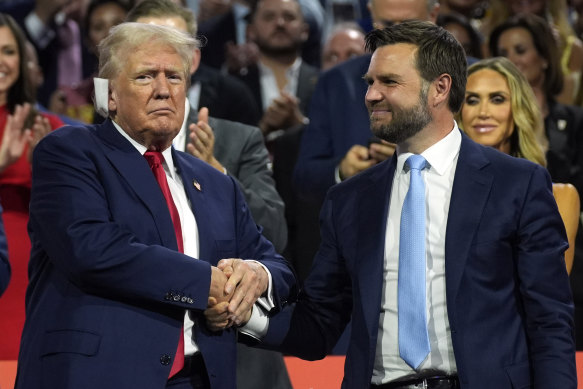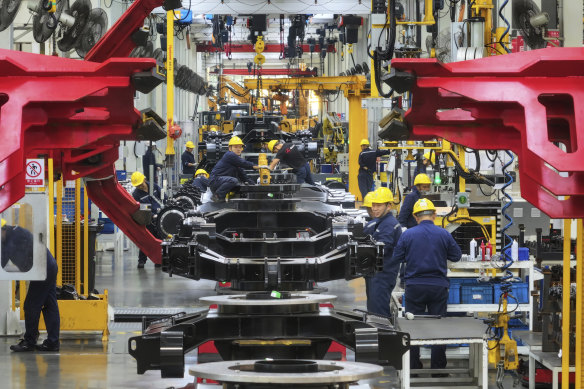Opinion
Trump’s shadow looms larger over China
Stephen Bartholomeusz
Senior business columnistWhen the senior leadership of China’s Communist Party gathered in Beijing for their five-yearly “third plenum” this week, they would have been monitoring recent developments in the US with some concern.
Coming so soon after Joe Biden’s disastrous performance in his debate with Donald Trump, the attempted assassination of Trump seems to have provided even more momentum for his campaign and increased the likelihood that Trump’s proposed 60 per cent tariff on Chinese exports to the US will be imposed.

Former US President Donald Trump’s running mate, J.D. Vance, is even more hawkish towards China.Credit: AP
His choice of running mate, J.D. Vance, will add to their concern. If anything, Vance is even more of an isolationist and protectionist and more hawkish towards China than Trump. In his first interviews after being named Trump’s candidate for the vice presidency, he nominated China as the biggest threat to the US.
The third plenum, held behind closed doors, focuses on economic issues and is one of seven meetings between the party’s five-yearly congresses. The vulnerability within Xi Jinping’s “high-quality development” strategy, in which the ambition is for China to dominate high-tech industries, is access to global markets.
Trump’s transactional view of trade (he thinks countries that have trade surpluses with the US, such as China, are ripping America off) and his misunderstanding of how tariffs work (they are a tax on companies and consumers within the economy that imposes them) means the threat of a 60 per cent tariff wall against imports from China is becoming ever more real.
How severe would that impact be?
UBS economists released a report this week in which they estimated it would carve 2.5 percentage points off China’s GDP growth rate, effectively halving its current rate of about 5 per cent. The report said about half the drag on growth would come from a decline in net exports and the rest from the indirect impact on consumption and investment.
Policy support to mitigate the negative impacts could reduce the hit to GDP growth to about 150 basis points.
Their forecasts are based on China not retaliating with its own tariffs on US exports – which would probably increase the negative impact on China’s economy via higher import costs – along with the occurrence of some diversion of trade to other economies, and that other economies don’t impose additional tariffs on China’s exports.
If action by the US was to divert China’s exports into other markets, the EU would be the most obvious target.
China is highly reliant on exports. The collapse of its property sector over the past three years is continuing and continues to cast a pall over consumer confidence and domestic consumption.
Data released by China’s National Bureau of Statistics at the start of the week shows real estate investment fell another 10.6 per cent in the June half-year (relative to the same period last year), with new construction starts down 23.7 per cent.
New home prices fell 4.5 per cent year-on-year, and the price of established homes 7.9 per cent.
While China announced in May a package of measures to try to stabilise the property sector, including reducing mortgage interest rates and allowing local governments to acquire unsold properties for social housing, it has resisted the temptation to embark on any significant efforts to boost consumption.
Instead, it has been ploughing funds into investment in manufacturing. Such investment grew by 9.5 per cent in the June half. That emphasis on building more factories showed up in record exports, which were up 8.6 per cent in the June half.
Overall, however, economic growth in the June quarter of 4.7 per cent was lower than expected, and slowed from the 5.3 per cent rate generated in the March quarter.
Absent some bold effort to stimulate consumption, which seems unlikely given Xi’s stated aversion to such measures, China’s growth rate will be dependent on the success of Xi’s “high-quality” developments, or technologies such as semiconductors, artificial intelligence, robotics, big data, green technologies (particularly electric vehicles, batteries and solar panels) and the advanced manufacturing that he hopes can drive productivity.
For his strategy to be successful, China needs access to export markets.
If Trump wins in November and imposes his 60 per cent tariff on China’s exports – he also plans a 10 per cent tariff on all other US imports, including those from America’s allies – China will effectively be shut out of the massive US market.

China is confronting a glut of production that is causing alarm in Europe, its key market for EV exports.Credit: AP
The European Union is leaning towards imposing increased tariffs of up to 38 per cent on Chinese electric vehicles. It is also considering an increase to the tariffs on its solar panels and wind turbines.
If action by the US were to divert China’s exports into other markets, the EU would be the most obvious target and would be under pressure from its domestic manufacturers to respond with even more trade barriers.
The massive state-directed increase in China’s manufacturing capacity has resulted in significant excess capacity, particularly in EVs and solar panels, which has already resulted in a flood of cheap manufactures into the global market that has caused increasing concern – and increased tariffs – in other economies, and not just in the US and Europe.
Past third plenums have produced radical shifts in China’s economic policies, generally producing significant market-based reforms. However, expectations for changes flowing from this plenum are low.
Some changes to China’s tax system to bail out its highly indebted local governments have been speculated, but Western pleas for China to defuse the rising trade tensions by adopting a more balanced growth strategy are almost certain to fall on deaf ears.
Xi is committed to a factory-led restructuring of China’s economy to reduce its dependence on Western technology and inputs, and to establish global dominance of green and other advanced technologies.
The shortening odds of a second Trump presidency, and the prospect of a new and broader round of trade wars than he initiated in his last term, pose a challenge to that strategy.
The Business Briefing newsletter delivers major stories, exclusive coverage and expert opinion. Sign up to get it every weekday morning.